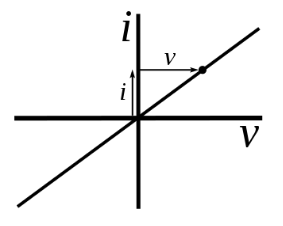
What is Ohm's Law graph?
Answer
417k+ views
Hint:The rule was named after German physicist Georg Ohm, who reported measurements of applied voltage and current via basic electrical circuits comprising varying lengths of wire in a book published in 1827. Ohm's experimental results were described by a somewhat more complicated equation than the current one above.
Complete answer:
According to Ohm's law, the current flowing through a conductor between two locations is proportional to the voltage across the conductor. When the proportionality constant, resistance, is included, the typical mathematical equation that explains this connection emerges:
where
The above equation cannot be termed Ohm's law if the resistance is not constant, but it may still be used to define static/DC resistance. The conductivity of the great majority of electrically conductive materials is properly described by Ohm's law across several orders of magnitude of current.
Non-ohmic materials, on the other hand, do not follow Ohm's law.When a conductor is kept at a constant temperature, Ohm's Law states that the current flowing through it is proportional to the voltage across it. This means that if we plot voltage on the x-axis and current on the y-axis of a graph, the result will be a straight line. The resistance of the conductor is linked to the gradient of the straight-line graph as

Note:For most materials, Ohm's law is an empirical law, a generalisation of numerous experiments that have demonstrated that current is roughly proportional to electric field. It is not usually followed and is less basic than Maxwell's equations. Under a high enough electric field, any material will break down, and some materials of importance in electrical engineering are "non-ohmic" under weak fields.
Complete answer:
According to Ohm's law, the current flowing through a conductor between two locations is proportional to the voltage across the conductor. When the proportionality constant, resistance, is included, the typical mathematical equation that explains this connection emerges:
where
The above equation cannot be termed Ohm's law if the resistance is not constant, but it may still be used to define static/DC resistance. The conductivity of the great majority of electrically conductive materials is properly described by Ohm's law across several orders of magnitude of current.
Non-ohmic materials, on the other hand, do not follow Ohm's law.When a conductor is kept at a constant temperature, Ohm's Law states that the current flowing through it is proportional to the voltage across it. This means that if we plot voltage on the x-axis and current on the y-axis of a graph, the result will be a straight line. The resistance of the conductor is linked to the gradient of the straight-line graph as

Note:For most materials, Ohm's law is an empirical law, a generalisation of numerous experiments that have demonstrated that current is roughly proportional to electric field. It is not usually followed and is less basic than Maxwell's equations. Under a high enough electric field, any material will break down, and some materials of importance in electrical engineering are "non-ohmic" under weak fields.
Recently Updated Pages
Master Class 9 General Knowledge: Engaging Questions & Answers for Success

Master Class 9 English: Engaging Questions & Answers for Success

Master Class 9 Science: Engaging Questions & Answers for Success

Master Class 9 Social Science: Engaging Questions & Answers for Success

Master Class 9 Maths: Engaging Questions & Answers for Success

Class 9 Question and Answer - Your Ultimate Solutions Guide

Trending doubts
Where did Netaji set up the INA headquarters A Yangon class 10 social studies CBSE

A boat goes 24 km upstream and 28 km downstream in class 10 maths CBSE

Why is there a time difference of about 5 hours between class 10 social science CBSE

The British separated Burma Myanmar from India in 1935 class 10 social science CBSE

The Equation xxx + 2 is Satisfied when x is Equal to Class 10 Maths

Chandigarh is the capital of A Punjab B Haryana C Punjab class 10 social science CBSE




